An Analysis of Current Trends in Music Education Practices
VerifiedAdded on 2023/03/17
|6
|1589
|78
Essay
AI Summary
This essay analyzes the major trends in contemporary music education, focusing on the impact of technology, the evolving role of teachers, and the use of digital resources. The essay references the article "Seeking 'success' in popular music" to explore how technology has transformed music composition and education. It examines the integration of technology in classrooms, the shift of teachers towards becoming composers, the rise of collaborative projects, and the impact of digital recordings on music education. The essay highlights the importance of adapting music education to reflect the changes in the music industry, emphasizing the need for educational institutions to update their teaching methods to improve students' understanding and application of contemporary music. The essay concludes by advocating for further research to improve the quality of music education.
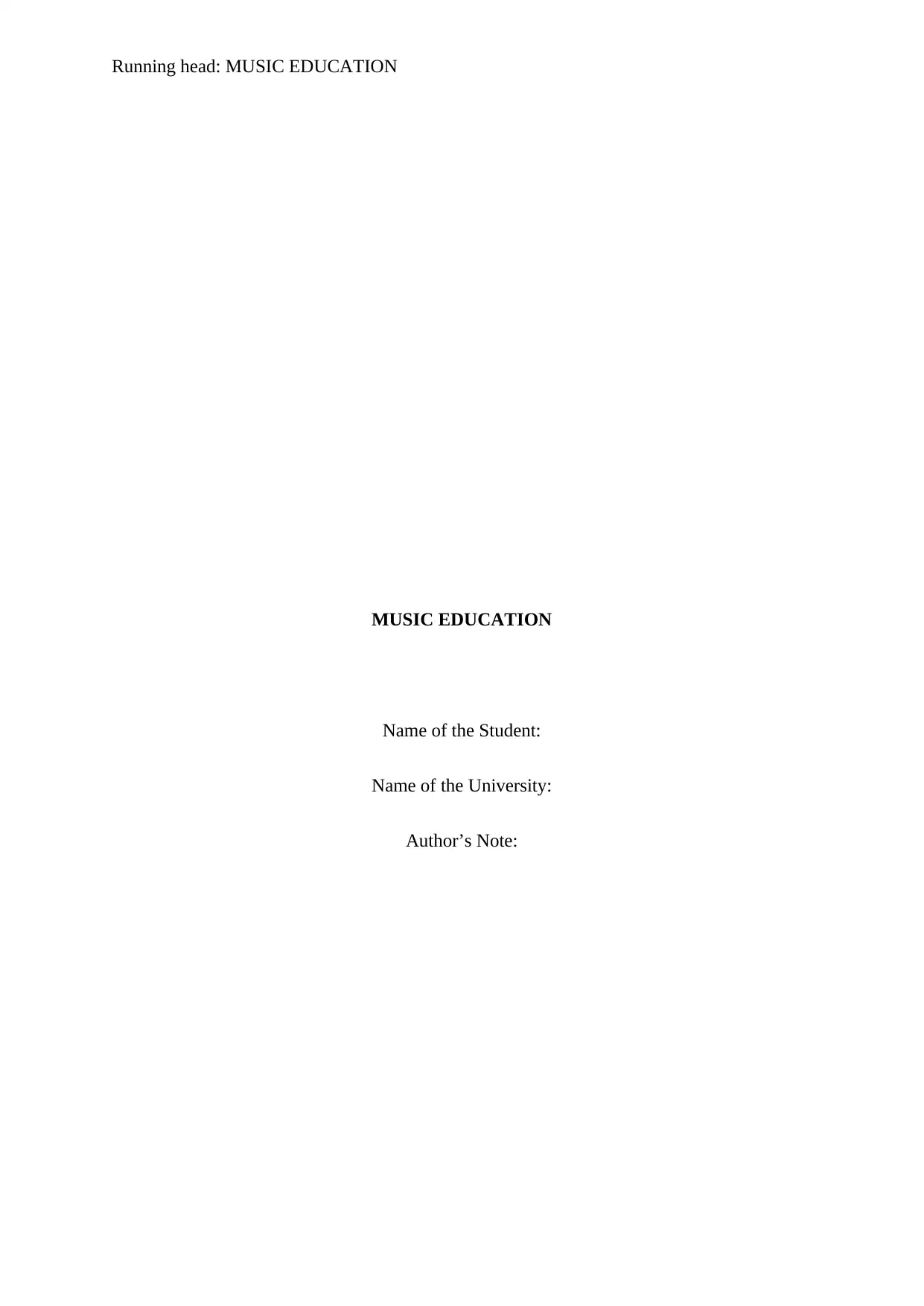
Running head: MUSIC EDUCATION
MUSIC EDUCATION
Name of the Student:
Name of the University:
Author’s Note:
MUSIC EDUCATION
Name of the Student:
Name of the University:
Author’s Note:
Paraphrase This Document
Need a fresh take? Get an instant paraphrase of this document with our AI Paraphraser
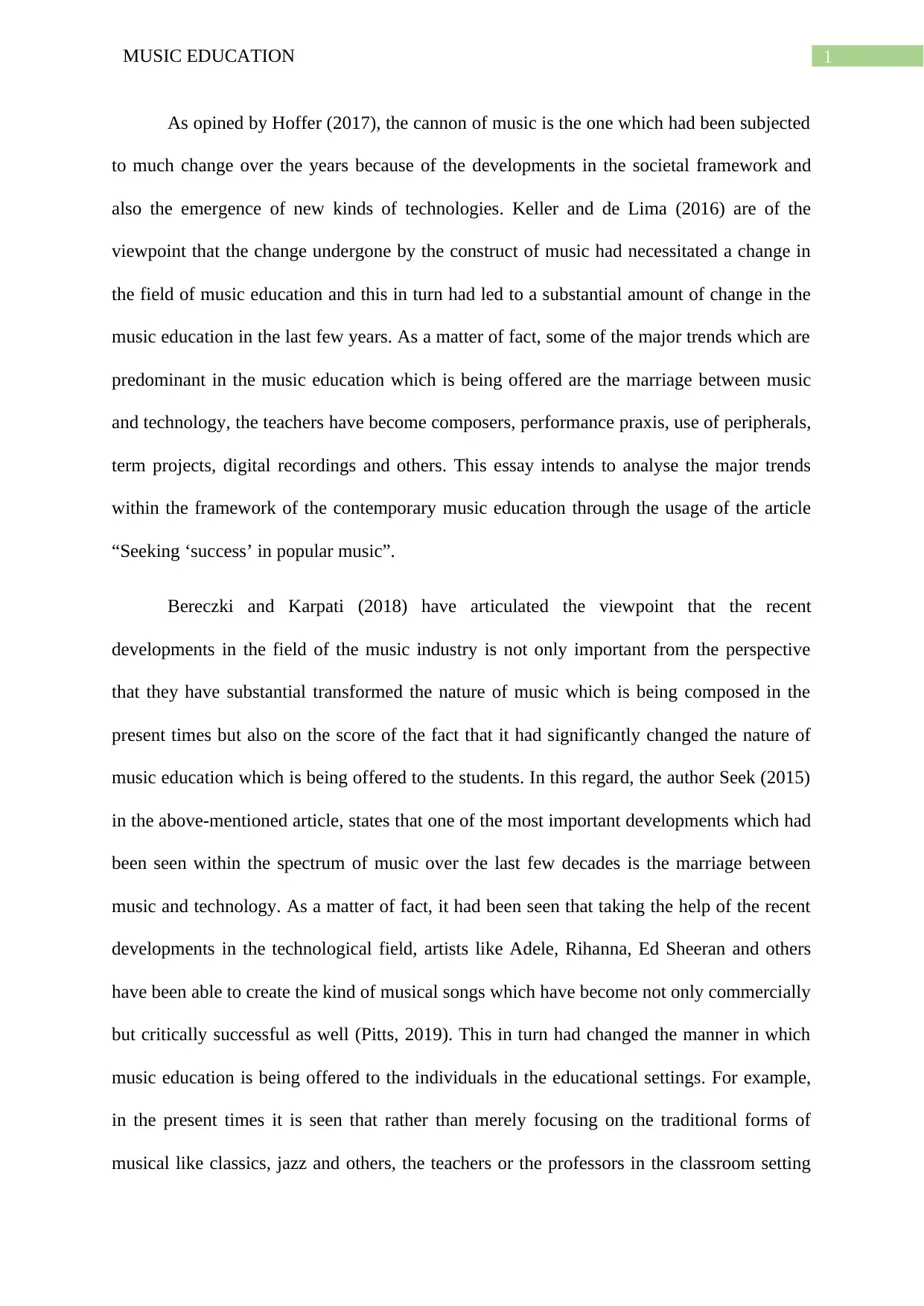
1MUSIC EDUCATION
As opined by Hoffer (2017), the cannon of music is the one which had been subjected
to much change over the years because of the developments in the societal framework and
also the emergence of new kinds of technologies. Keller and de Lima (2016) are of the
viewpoint that the change undergone by the construct of music had necessitated a change in
the field of music education and this in turn had led to a substantial amount of change in the
music education in the last few years. As a matter of fact, some of the major trends which are
predominant in the music education which is being offered are the marriage between music
and technology, the teachers have become composers, performance praxis, use of peripherals,
term projects, digital recordings and others. This essay intends to analyse the major trends
within the framework of the contemporary music education through the usage of the article
“Seeking ‘success’ in popular music”.
Bereczki and Karpati (2018) have articulated the viewpoint that the recent
developments in the field of the music industry is not only important from the perspective
that they have substantial transformed the nature of music which is being composed in the
present times but also on the score of the fact that it had significantly changed the nature of
music education which is being offered to the students. In this regard, the author Seek (2015)
in the above-mentioned article, states that one of the most important developments which had
been seen within the spectrum of music over the last few decades is the marriage between
music and technology. As a matter of fact, it had been seen that taking the help of the recent
developments in the technological field, artists like Adele, Rihanna, Ed Sheeran and others
have been able to create the kind of musical songs which have become not only commercially
but critically successful as well (Pitts, 2019). This in turn had changed the manner in which
music education is being offered to the individuals in the educational settings. For example,
in the present times it is seen that rather than merely focusing on the traditional forms of
musical like classics, jazz and others, the teachers or the professors in the classroom setting
As opined by Hoffer (2017), the cannon of music is the one which had been subjected
to much change over the years because of the developments in the societal framework and
also the emergence of new kinds of technologies. Keller and de Lima (2016) are of the
viewpoint that the change undergone by the construct of music had necessitated a change in
the field of music education and this in turn had led to a substantial amount of change in the
music education in the last few years. As a matter of fact, some of the major trends which are
predominant in the music education which is being offered are the marriage between music
and technology, the teachers have become composers, performance praxis, use of peripherals,
term projects, digital recordings and others. This essay intends to analyse the major trends
within the framework of the contemporary music education through the usage of the article
“Seeking ‘success’ in popular music”.
Bereczki and Karpati (2018) have articulated the viewpoint that the recent
developments in the field of the music industry is not only important from the perspective
that they have substantial transformed the nature of music which is being composed in the
present times but also on the score of the fact that it had significantly changed the nature of
music education which is being offered to the students. In this regard, the author Seek (2015)
in the above-mentioned article, states that one of the most important developments which had
been seen within the spectrum of music over the last few decades is the marriage between
music and technology. As a matter of fact, it had been seen that taking the help of the recent
developments in the technological field, artists like Adele, Rihanna, Ed Sheeran and others
have been able to create the kind of musical songs which have become not only commercially
but critically successful as well (Pitts, 2019). This in turn had changed the manner in which
music education is being offered to the individuals in the educational settings. For example,
in the present times it is seen that rather than merely focusing on the traditional forms of
musical like classics, jazz and others, the teachers or the professors in the classroom setting
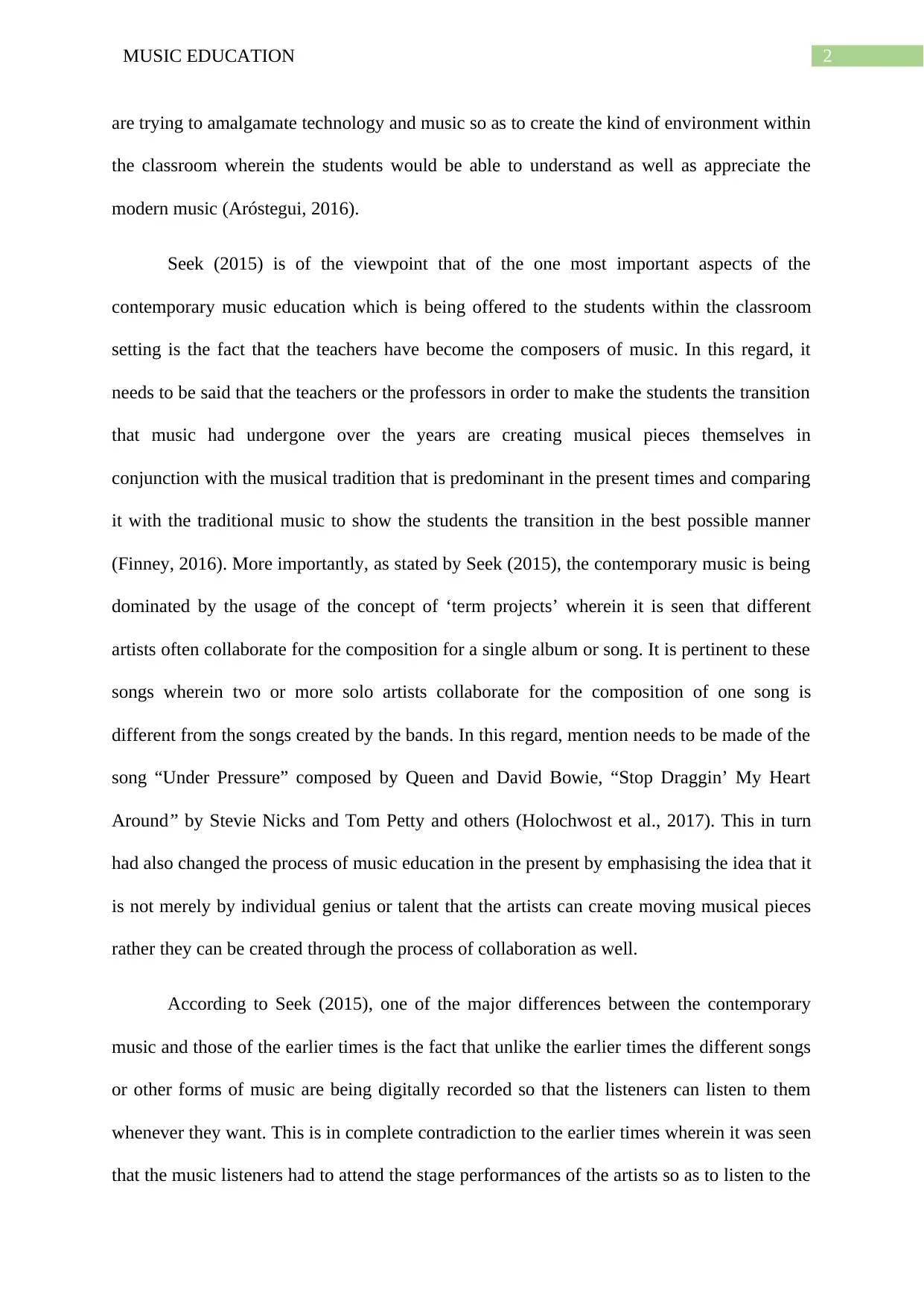
2MUSIC EDUCATION
are trying to amalgamate technology and music so as to create the kind of environment within
the classroom wherein the students would be able to understand as well as appreciate the
modern music (Aróstegui, 2016).
Seek (2015) is of the viewpoint that of the one most important aspects of the
contemporary music education which is being offered to the students within the classroom
setting is the fact that the teachers have become the composers of music. In this regard, it
needs to be said that the teachers or the professors in order to make the students the transition
that music had undergone over the years are creating musical pieces themselves in
conjunction with the musical tradition that is predominant in the present times and comparing
it with the traditional music to show the students the transition in the best possible manner
(Finney, 2016). More importantly, as stated by Seek (2015), the contemporary music is being
dominated by the usage of the concept of ‘term projects’ wherein it is seen that different
artists often collaborate for the composition for a single album or song. It is pertinent to these
songs wherein two or more solo artists collaborate for the composition of one song is
different from the songs created by the bands. In this regard, mention needs to be made of the
song “Under Pressure” composed by Queen and David Bowie, “Stop Draggin’ My Heart
Around ” by Stevie Nicks and Tom Petty and others (Holochwost et al., 2017). This in turn
had also changed the process of music education in the present by emphasising the idea that it
is not merely by individual genius or talent that the artists can create moving musical pieces
rather they can be created through the process of collaboration as well.
According to Seek (2015), one of the major differences between the contemporary
music and those of the earlier times is the fact that unlike the earlier times the different songs
or other forms of music are being digitally recorded so that the listeners can listen to them
whenever they want. This is in complete contradiction to the earlier times wherein it was seen
that the music listeners had to attend the stage performances of the artists so as to listen to the
are trying to amalgamate technology and music so as to create the kind of environment within
the classroom wherein the students would be able to understand as well as appreciate the
modern music (Aróstegui, 2016).
Seek (2015) is of the viewpoint that of the one most important aspects of the
contemporary music education which is being offered to the students within the classroom
setting is the fact that the teachers have become the composers of music. In this regard, it
needs to be said that the teachers or the professors in order to make the students the transition
that music had undergone over the years are creating musical pieces themselves in
conjunction with the musical tradition that is predominant in the present times and comparing
it with the traditional music to show the students the transition in the best possible manner
(Finney, 2016). More importantly, as stated by Seek (2015), the contemporary music is being
dominated by the usage of the concept of ‘term projects’ wherein it is seen that different
artists often collaborate for the composition for a single album or song. It is pertinent to these
songs wherein two or more solo artists collaborate for the composition of one song is
different from the songs created by the bands. In this regard, mention needs to be made of the
song “Under Pressure” composed by Queen and David Bowie, “Stop Draggin’ My Heart
Around ” by Stevie Nicks and Tom Petty and others (Holochwost et al., 2017). This in turn
had also changed the process of music education in the present by emphasising the idea that it
is not merely by individual genius or talent that the artists can create moving musical pieces
rather they can be created through the process of collaboration as well.
According to Seek (2015), one of the major differences between the contemporary
music and those of the earlier times is the fact that unlike the earlier times the different songs
or other forms of music are being digitally recorded so that the listeners can listen to them
whenever they want. This is in complete contradiction to the earlier times wherein it was seen
that the music listeners had to attend the stage performances of the artists so as to listen to the
⊘ This is a preview!⊘
Do you want full access?
Subscribe today to unlock all pages.

Trusted by 1+ million students worldwide
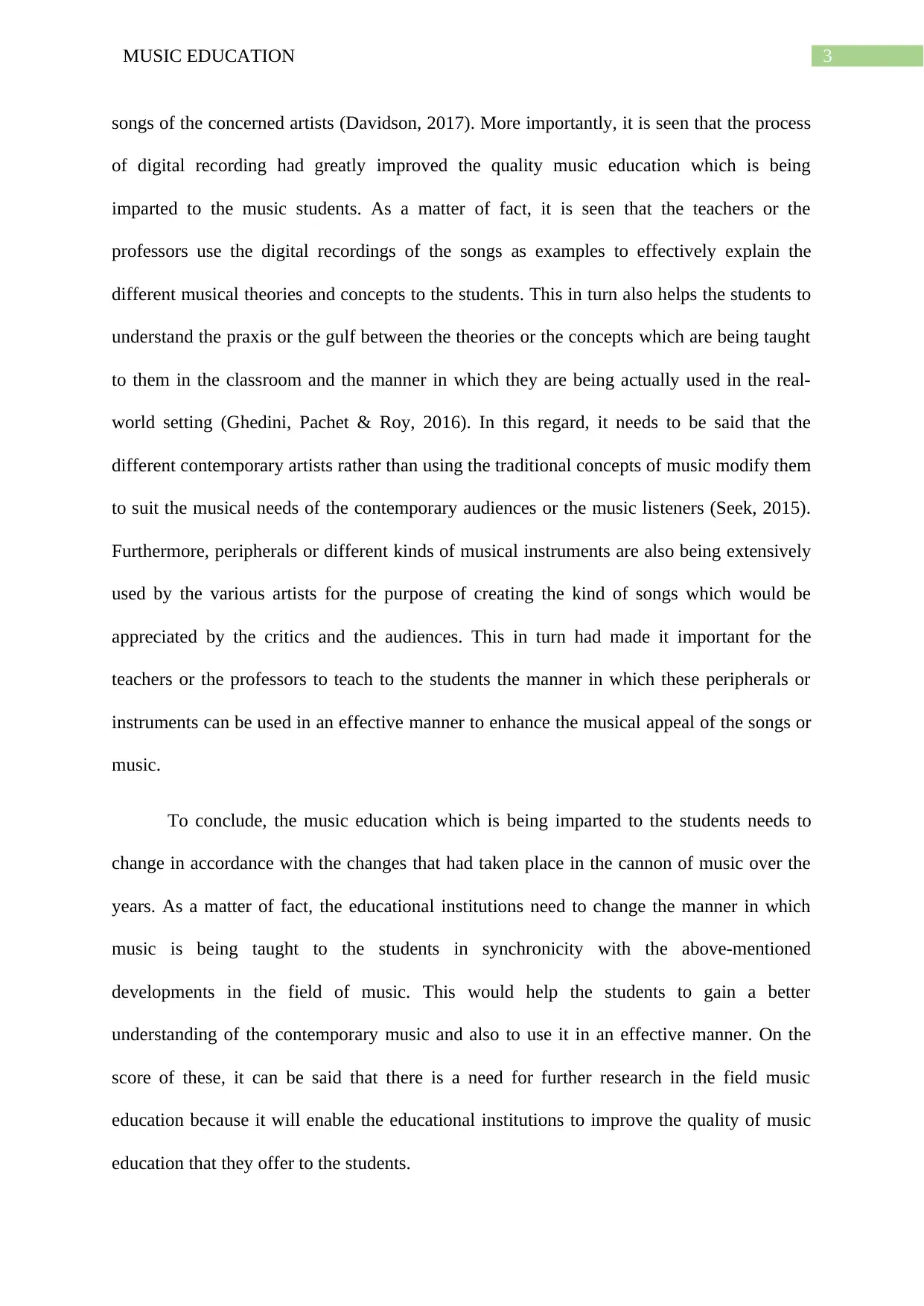
3MUSIC EDUCATION
songs of the concerned artists (Davidson, 2017). More importantly, it is seen that the process
of digital recording had greatly improved the quality music education which is being
imparted to the music students. As a matter of fact, it is seen that the teachers or the
professors use the digital recordings of the songs as examples to effectively explain the
different musical theories and concepts to the students. This in turn also helps the students to
understand the praxis or the gulf between the theories or the concepts which are being taught
to them in the classroom and the manner in which they are being actually used in the real-
world setting (Ghedini, Pachet & Roy, 2016). In this regard, it needs to be said that the
different contemporary artists rather than using the traditional concepts of music modify them
to suit the musical needs of the contemporary audiences or the music listeners (Seek, 2015).
Furthermore, peripherals or different kinds of musical instruments are also being extensively
used by the various artists for the purpose of creating the kind of songs which would be
appreciated by the critics and the audiences. This in turn had made it important for the
teachers or the professors to teach to the students the manner in which these peripherals or
instruments can be used in an effective manner to enhance the musical appeal of the songs or
music.
To conclude, the music education which is being imparted to the students needs to
change in accordance with the changes that had taken place in the cannon of music over the
years. As a matter of fact, the educational institutions need to change the manner in which
music is being taught to the students in synchronicity with the above-mentioned
developments in the field of music. This would help the students to gain a better
understanding of the contemporary music and also to use it in an effective manner. On the
score of these, it can be said that there is a need for further research in the field music
education because it will enable the educational institutions to improve the quality of music
education that they offer to the students.
songs of the concerned artists (Davidson, 2017). More importantly, it is seen that the process
of digital recording had greatly improved the quality music education which is being
imparted to the music students. As a matter of fact, it is seen that the teachers or the
professors use the digital recordings of the songs as examples to effectively explain the
different musical theories and concepts to the students. This in turn also helps the students to
understand the praxis or the gulf between the theories or the concepts which are being taught
to them in the classroom and the manner in which they are being actually used in the real-
world setting (Ghedini, Pachet & Roy, 2016). In this regard, it needs to be said that the
different contemporary artists rather than using the traditional concepts of music modify them
to suit the musical needs of the contemporary audiences or the music listeners (Seek, 2015).
Furthermore, peripherals or different kinds of musical instruments are also being extensively
used by the various artists for the purpose of creating the kind of songs which would be
appreciated by the critics and the audiences. This in turn had made it important for the
teachers or the professors to teach to the students the manner in which these peripherals or
instruments can be used in an effective manner to enhance the musical appeal of the songs or
music.
To conclude, the music education which is being imparted to the students needs to
change in accordance with the changes that had taken place in the cannon of music over the
years. As a matter of fact, the educational institutions need to change the manner in which
music is being taught to the students in synchronicity with the above-mentioned
developments in the field of music. This would help the students to gain a better
understanding of the contemporary music and also to use it in an effective manner. On the
score of these, it can be said that there is a need for further research in the field music
education because it will enable the educational institutions to improve the quality of music
education that they offer to the students.
Paraphrase This Document
Need a fresh take? Get an instant paraphrase of this document with our AI Paraphraser
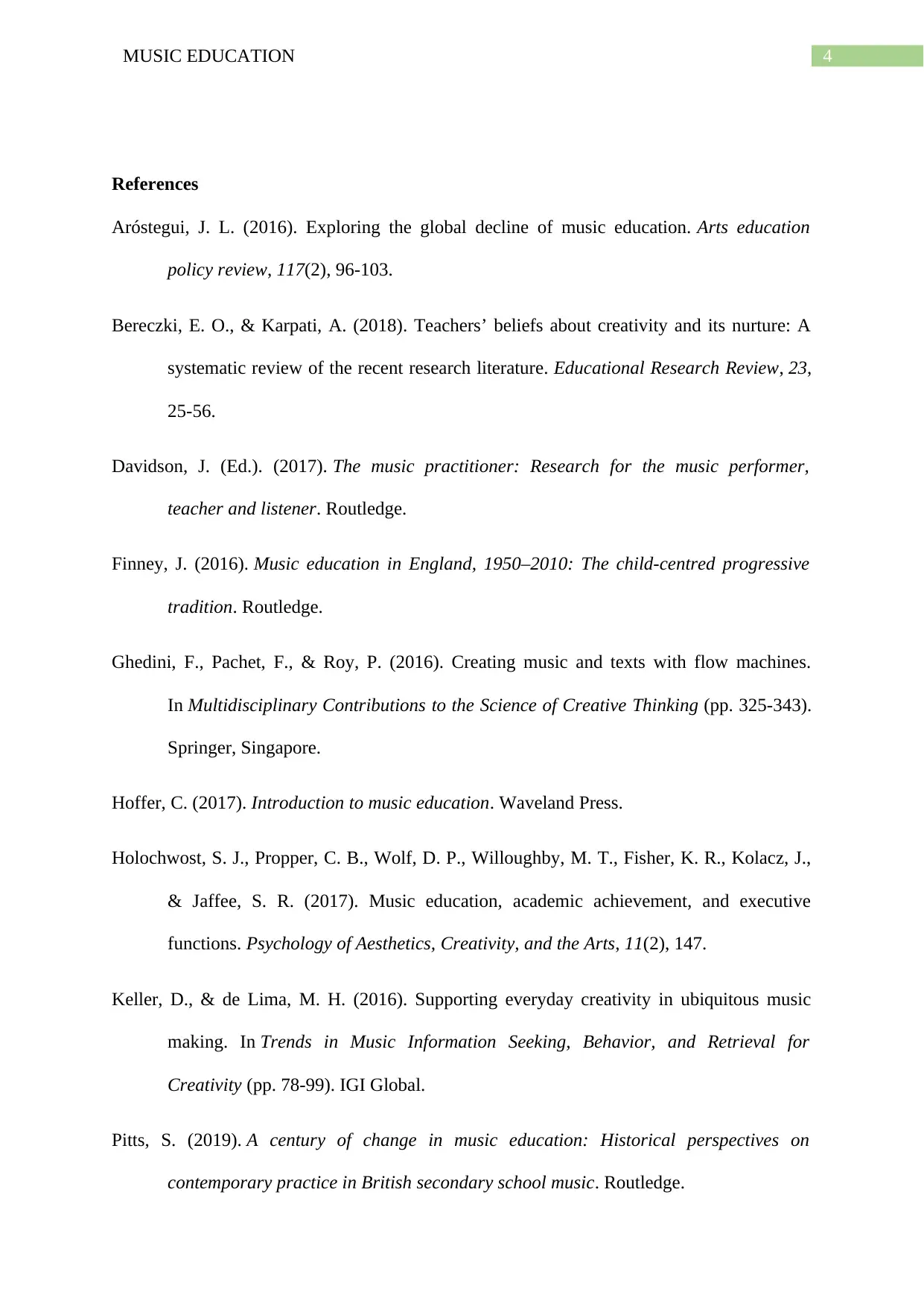
4MUSIC EDUCATION
References
Aróstegui, J. L. (2016). Exploring the global decline of music education. Arts education
policy review, 117(2), 96-103.
Bereczki, E. O., & Karpati, A. (2018). Teachers’ beliefs about creativity and its nurture: A
systematic review of the recent research literature. Educational Research Review, 23,
25-56.
Davidson, J. (Ed.). (2017). The music practitioner: Research for the music performer,
teacher and listener. Routledge.
Finney, J. (2016). Music education in England, 1950–2010: The child-centred progressive
tradition. Routledge.
Ghedini, F., Pachet, F., & Roy, P. (2016). Creating music and texts with flow machines.
In Multidisciplinary Contributions to the Science of Creative Thinking (pp. 325-343).
Springer, Singapore.
Hoffer, C. (2017). Introduction to music education. Waveland Press.
Holochwost, S. J., Propper, C. B., Wolf, D. P., Willoughby, M. T., Fisher, K. R., Kolacz, J.,
& Jaffee, S. R. (2017). Music education, academic achievement, and executive
functions. Psychology of Aesthetics, Creativity, and the Arts, 11(2), 147.
Keller, D., & de Lima, M. H. (2016). Supporting everyday creativity in ubiquitous music
making. In Trends in Music Information Seeking, Behavior, and Retrieval for
Creativity (pp. 78-99). IGI Global.
Pitts, S. (2019). A century of change in music education: Historical perspectives on
contemporary practice in British secondary school music. Routledge.
References
Aróstegui, J. L. (2016). Exploring the global decline of music education. Arts education
policy review, 117(2), 96-103.
Bereczki, E. O., & Karpati, A. (2018). Teachers’ beliefs about creativity and its nurture: A
systematic review of the recent research literature. Educational Research Review, 23,
25-56.
Davidson, J. (Ed.). (2017). The music practitioner: Research for the music performer,
teacher and listener. Routledge.
Finney, J. (2016). Music education in England, 1950–2010: The child-centred progressive
tradition. Routledge.
Ghedini, F., Pachet, F., & Roy, P. (2016). Creating music and texts with flow machines.
In Multidisciplinary Contributions to the Science of Creative Thinking (pp. 325-343).
Springer, Singapore.
Hoffer, C. (2017). Introduction to music education. Waveland Press.
Holochwost, S. J., Propper, C. B., Wolf, D. P., Willoughby, M. T., Fisher, K. R., Kolacz, J.,
& Jaffee, S. R. (2017). Music education, academic achievement, and executive
functions. Psychology of Aesthetics, Creativity, and the Arts, 11(2), 147.
Keller, D., & de Lima, M. H. (2016). Supporting everyday creativity in ubiquitous music
making. In Trends in Music Information Seeking, Behavior, and Retrieval for
Creativity (pp. 78-99). IGI Global.
Pitts, S. (2019). A century of change in music education: Historical perspectives on
contemporary practice in British secondary school music. Routledge.
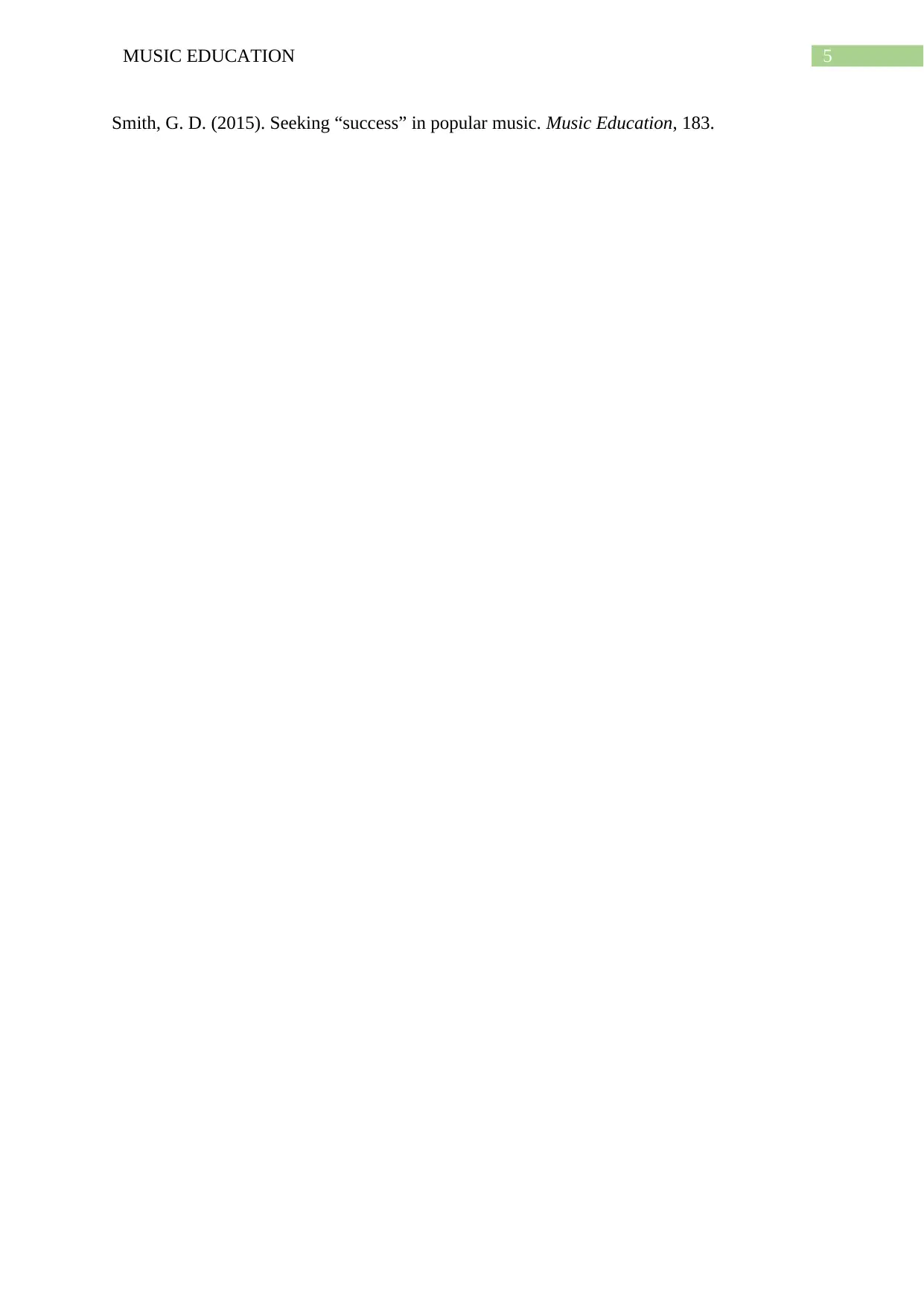
5MUSIC EDUCATION
Smith, G. D. (2015). Seeking “success” in popular music. Music Education, 183.
Smith, G. D. (2015). Seeking “success” in popular music. Music Education, 183.
⊘ This is a preview!⊘
Do you want full access?
Subscribe today to unlock all pages.

Trusted by 1+ million students worldwide
1 out of 6
Related Documents
Your All-in-One AI-Powered Toolkit for Academic Success.
+13062052269
info@desklib.com
Available 24*7 on WhatsApp / Email
![[object Object]](/_next/static/media/star-bottom.7253800d.svg)
Unlock your academic potential
Copyright © 2020–2025 A2Z Services. All Rights Reserved. Developed and managed by ZUCOL.




